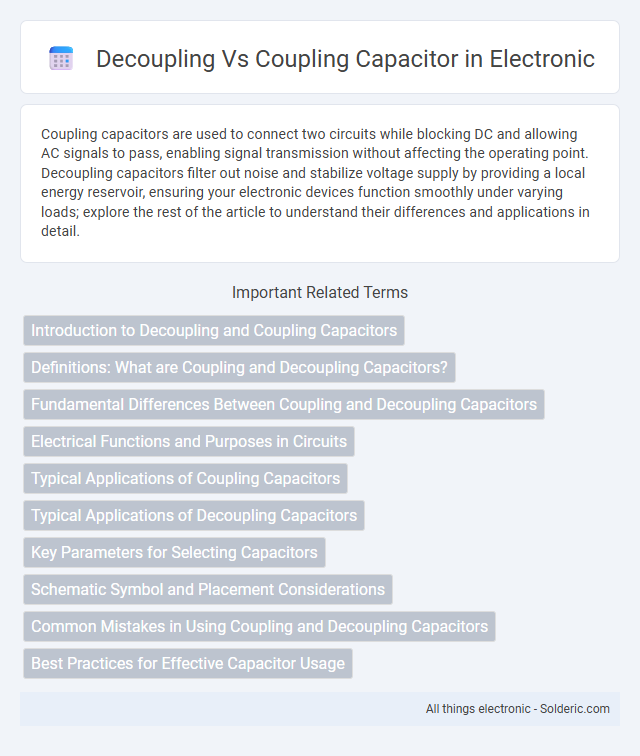Coupling capacitors are used to connect two circuits while blocking DC and allowing AC signals to pass, enabling signal transmission without affecting the operating point. Decoupling capacitors filter out noise and stabilize voltage supply by providing a local energy reservoir, ensuring your electronic devices function smoothly under varying loads; explore the rest of the article to understand their differences and applications in detail.
Comparison Table
| Feature | Decoupling Capacitor | Coupling Capacitor |
|---|---|---|
| Primary Function | Suppress voltage noise and stabilize power supply | Transfer AC signals between stages, blocking DC |
| Typical Placement | Between power supply and ground near ICs | Between amplifier stages or signal paths |
| Capacitance Range | Usually small (0.01uF to 0.1uF) | Can vary widely (pF to uF) depending on frequency |
| Effect on Signal | Reduces voltage ripple, minimal impact on signal | Blocks DC, passes AC signals |
| Common Types | Ceramic, multilayer capacitors | Electrolytic, film, ceramic capacitors |
| Electrical Behavior | Acts as a local energy reservoir to reduce noise | Acts as a high-pass filter in signal path |
Introduction to Decoupling and Coupling Capacitors
Decoupling capacitors stabilize power supply voltage by filtering out noise and transients, ensuring reliable operation of integrated circuits. Coupling capacitors, in contrast, allow AC signals to pass between circuit stages while blocking DC components, preserving signal integrity. Both capacitors play crucial roles in electronic circuit design, balancing noise reduction and signal transmission.
Definitions: What are Coupling and Decoupling Capacitors?
Coupling capacitors are used to transmit AC signals between circuit stages while blocking DC components, ensuring signal integrity without altering the DC biasing conditions. Decoupling capacitors, also known as bypass capacitors, stabilize voltage supply lines by filtering out noise and transient voltage spikes, protecting sensitive components in your electronic circuits. Understanding the distinct roles of coupling and decoupling capacitors is essential for optimizing signal performance and power stability in electronic design.
Fundamental Differences Between Coupling and Decoupling Capacitors
Coupling capacitors are designed to transmit AC signals between circuit stages while blocking DC components, preserving signal integrity. Decoupling capacitors stabilize voltage supply lines by filtering noise and transients, ensuring consistent power delivery. You should select coupling capacitors for signal path isolation and decoupling capacitors for power supply noise reduction in your design.
Electrical Functions and Purposes in Circuits
Decoupling capacitors stabilize voltage supply by filtering out high-frequency noise, ensuring smooth operation of sensitive components, while coupling capacitors enable signal transmission between circuit stages by blocking DC voltage and allowing AC signals to pass. Decoupling capacitors are placed close to power pins of integrated circuits to prevent voltage fluctuations, whereas coupling capacitors connect input and output stages to maintain signal integrity. Both types play critical roles in enhancing circuit performance by managing power supply quality and signal flow effectively.
Typical Applications of Coupling Capacitors
Coupling capacitors are commonly used in audio equipment, radio frequency (RF) circuits, and signal processing to block DC components while allowing AC signals to pass, preserving signal integrity between stages. They enable seamless transfer of varying voltage signals without disturbing the biasing conditions of active components, essential in amplifiers and oscillators. Your designs benefit from coupling capacitors by maintaining stable operation and preventing DC offset issues in interconnected circuit blocks.
Typical Applications of Decoupling Capacitors
Decoupling capacitors are primarily used in digital and mixed-signal circuits to stabilize power supply voltage by filtering out voltage spikes and high-frequency noise. They are placed close to integrated circuits (ICs) such as microprocessors, microcontrollers, and memory chips to ensure a clean and stable power line, improving overall circuit reliability and performance. Typical applications include reducing electromagnetic interference (EMI) and preventing voltage fluctuations that can cause malfunction or data errors.
Key Parameters for Selecting Capacitors
Key parameters for selecting decoupling and coupling capacitors include capacitance value, voltage rating, equivalent series resistance (ESR), and frequency response. Decoupling capacitors require low ESR and high-frequency performance to filter noise effectively, while coupling capacitors prioritize stable capacitance and low leakage for signal integrity. Your choice depends on the specific application and operating environment to ensure optimal circuit performance.
Schematic Symbol and Placement Considerations
Decoupling capacitors are typically represented with a standard capacitor symbol placed close to power pins of ICs to reduce noise and voltage fluctuations. Coupling capacitors share the same symbol but are inserted in series on signal lines to block DC components while allowing AC signals to pass. Placement considerations emphasize positioning decoupling capacitors as near as possible to the IC power pins, whereas coupling capacitors should be placed on signal paths where DC isolation is required.
Common Mistakes in Using Coupling and Decoupling Capacitors
Common mistakes in using coupling and decoupling capacitors include placing decoupling capacitors too far from the IC power pins, which reduces their effectiveness in filtering high-frequency noise. Using coupling capacitors with incorrect capacitance values can distort signal integrity by either blocking low-frequency components or failing to isolate DC bias properly. Ensuring your design accounts for proper capacitor placement and value selection optimizes circuit performance and prevents noise or signal distortion issues.
Best Practices for Effective Capacitor Usage
Decoupling and coupling capacitors serve distinct roles in circuit design, with decoupling capacitors stabilizing power supply lines by filtering out noise and coupling capacitors enabling AC signal transfer while blocking DC components. Best practices include placing decoupling capacitors as close to the power pins of ICs as possible to minimize inductance and using capacitors with appropriate values--typically 0.1uF ceramic for high-frequency noise suppression. For coupling capacitors, selecting values that ensure low reactance at the signal frequency preserves signal integrity, while avoiding large values that introduce unwanted low-frequency roll-off, thereby optimizing circuit performance.
decoupling vs coupling capacitor Infographic

 solderic.com
solderic.com